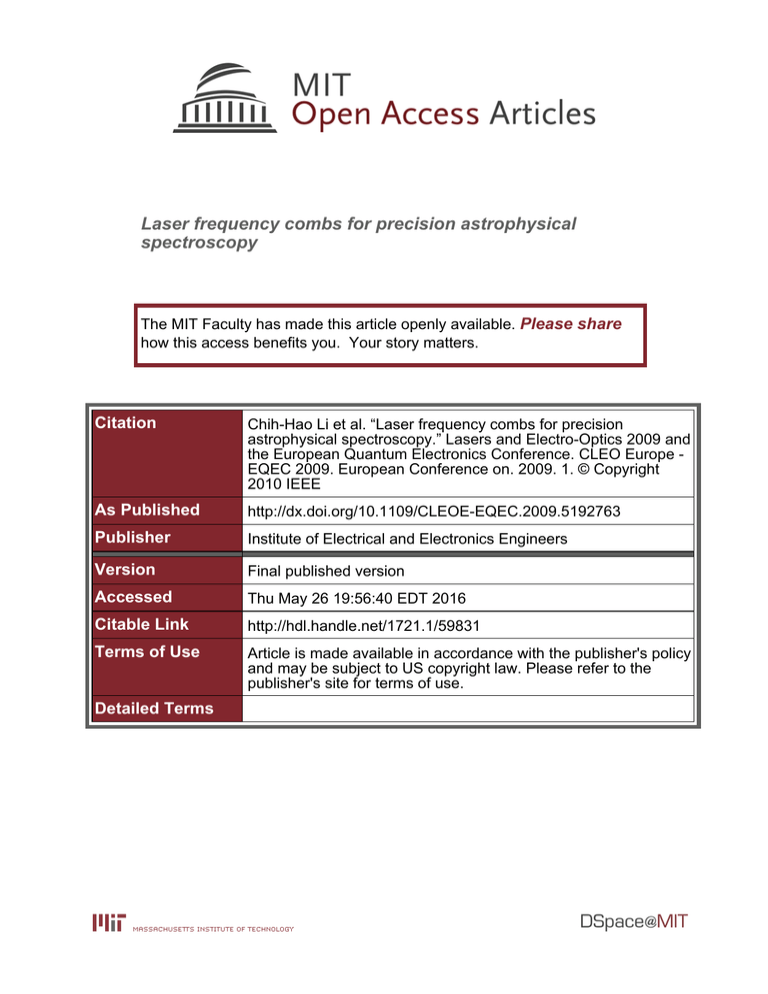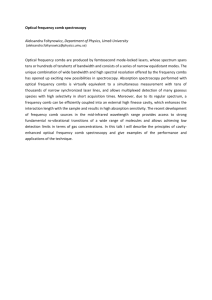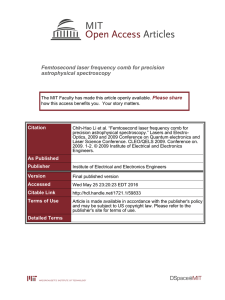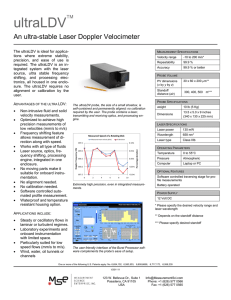Laser frequency combs for precision astrophysical spectroscopy Please share
advertisement

Laser frequency combs for precision astrophysical spectroscopy The MIT Faculty has made this article openly available. Please share how this access benefits you. Your story matters. Citation Chih-Hao Li et al. “Laser frequency combs for precision astrophysical spectroscopy.” Lasers and Electro-Optics 2009 and the European Quantum Electronics Conference. CLEO Europe EQEC 2009. European Conference on. 2009. 1. © Copyright 2010 IEEE As Published http://dx.doi.org/10.1109/CLEOE-EQEC.2009.5192763 Publisher Institute of Electrical and Electronics Engineers Version Final published version Accessed Thu May 26 19:56:40 EDT 2016 Citable Link http://hdl.handle.net/1721.1/59831 Terms of Use Article is made available in accordance with the publisher's policy and may be subject to US copyright law. Please refer to the publisher's site for terms of use. Detailed Terms Laser Frequency Combs for Precision Astrophysical Spectroscopy Chih-Hao Li1 , Andrew J. Benedick2 , Claire E. Cramer1 , Guoqing Chang2 , Li-Jin Chen2 , Peter Fendel2 , Gabor Furesz1 , Alexander G. Glenday1 , Franz X. Kaertner2 , David F. Phillips1 , Dimitar Sasselov1 , Andrew Szentgyorgyi1 and Ronald L. Walsworth1,∗ 1 Harvard-Smithsonian Center for Astrophysics, Massachusetts 02138, USA Institute of Technology, Massachusetts 02139, USA ∗ rwalsworth@cfa.harvard.edu 2 Massachusetts Searches for extrasolar planets using the periodic Doppler shift of stellar spectral lines resulting from the motion of the host star around the barycentre of an extrasolar system have recently achieved a precision of 60 cm/s [1]. To find a 1-Earth-mass planet in an Earth-like orbit, a precision of 5 cm/s is necessary. The sensitivity of astrophysical spectroscopy is presently limited by its wavelength calibration sources [2, 3]. The combination of a laser frequency comb with a Fabry-Perot (FP) filter cavity has been suggested as a promising approach to improved sensitivity [4-7]. Here we report the fabrication and tests of a filtered comb with up to 40-GHz (∼ 1 Å) line spacing, generated from a 1GHz repetition-rate source, without compromising long-term stability, reproducibility or spectral resolution [8]. This astro-comb is well matched to the resolving power of high-resolution astrophysical spectrographs. The astro-comb should allow a precision as high as 1 cm/s in astronomical radial velocity measurements. A 1-GHz repetition-rate Ti:sapphire laser generates comb lines spanning 6,000 Å to 12,000 Å. Both the repetition rate and the offset frequency are referenced to an atomic clock via low-noise synthesizers [Fig. 1(a)]. A FP cavity increases the line spacing by filtering unwanted comb lines, and is stabilized to a diode laser, which is phase-locked to the comb. With plane-parallel FP mirrors of 99% reflectivity and optimized group delay dispersion (< 50 fs2 ) in the range of 7,500 Å to 9,200 Å, we have observed astro-comb lines with up to 40-GHz spacing, spanning 1,000-Å. a) Mixer Phase lock box b) Synthesizer Photodetector Fabry-Perot cavity Astro-comb beam Octave-spanning 1-GHz laser frequency comb PZT To spectrograph λ/2 Diode laser PID lock box EOM Photodetector Synthesizer Mixer Fig. 1. (a) Astro-comb schematic. An octave spanning 1 GHz frequency comb, filtered by a Fabry-Perot cavity produces a 40 GHz comb feeding the spectrograph. (b) Spectrograph images of the sparse, irregular Th-Ar spectrum (above) and the dense, regular astro-comb spectrum (below). The astro-comb has been deployed to calibrate the TRES spectrograph for the 1.5-m telescope at Whipple Observatory. TRES is a multi-order echelle spectrograph with a resolving power of 60,000 and wavelength coverage from 3,800A-9,300 Å. A calibration image is shown in Fig. 1(b). Preliminary data analysis indicates that the astro-comb is able to improve the Doppler shift precision of TRES. We are currently employing the astro-comb and TRES in studies of exoplanets around M-dwarf stars. References 1. C. Lovis, et al., “An extrasolar planetary system with three Neptune-mass planets,” Nature, 441, 305-309 (2006); C. Lovis et al., “The exoplanet hunter HARPS: unequalled accuracy and perspectives toward 1 cm/s precision,” Proc. SPIE, 6269, 62690P 23 (2006). 2. S. Udry, et al., “The HARPS search for southern extra-solar planets XI. Super-Earths (5 & 8 M⊕ ) in a 3-planet system. Astron. Astrophys.” 469, L43-L47 (2007). 3. R. P. Butler, et al., “Attaining Doppler Precision of 3 m/s,” PASP, 108, 500-509 (1996). 4. M. T. Murphy, et al., “High-precision wavelength calibration with laser frequency combs,” Mon. Not. R. Astron. Soc. 380, 839847 (2007). 5. P. O. Schmidt, S. Kimeswengerg, H. U. Kaeufl, “A new generation of spectrometer calibration techniques based on optical frequency combs,” in Proc. 2007 ESO Instrument Calibration Workshop (ESO Astrophysics Symposia series, Springer, in the press); preprint at Ahttp://arxiv.org/abs/0705.0763v1a. 6. C. Araujo-Hauck, et al., “Future wavelength calibration standards at ESO: the laser frequency comb,” ESO Messenger 129, 2426 (2007). 7. S. Osterman et al., “A proposed laser frequency comb based wavelength reference for high resolution spectroscopy,” Proc. SPIE 6693, 66931G-19 (2007). 8. C.-H. Li et al., “A laser frequency comb that enables radial velocity measurements with a precision of 1 cm/s,” Nature 452, 610-612 (2008). c 978-1-4244-4080-1/09/$25.00 2009 IEEE







